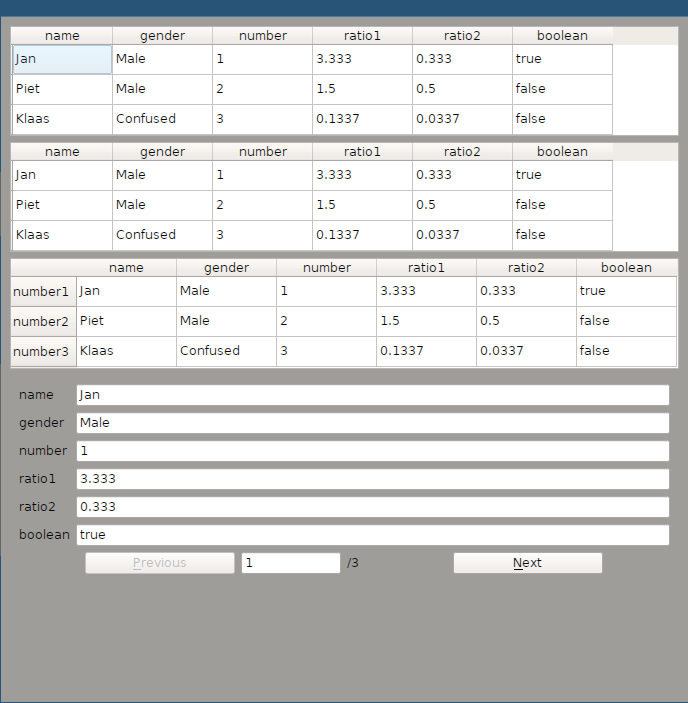Generic Qt gui
This project is a generalization of the generic gui implementation used in DMP. I use boost fusion to implement a Qt model adapter that can show data from standard c++ classes. You can than create a gui type, either a QTableWidget type or a custom form class. These classes will inspect the your custom fusion adapted data type and create all the neccesary boiler plate such as header names and functions that enable to set and get the underlying data. This means that when you edit the gui you edit the underlying datastructures directly. But I can better show you all a simple example that you can write using this system. I hope it shows off the expressive power more than a couple paragraphs of text would.
#include "main_window.hpp"
#include "fusion_model.hpp"
#include "qt_adapter.hpp"
#include "meta_types.hpp"
#include "fusion_outputter.hpp"
#include "form.hpp"
#include <boost/fusion/adapted.hpp>
#include <iostream>
struct Data {
const std::string name;
std::string gender;
uint32_t number;
const double ratio1;
double ratio2;
bool boolean;
};
BOOST_FUSION_ADAPT_STRUCT(
Data,
(const std::string, name)
(std::string, gender)
(uint32_t, number)
(const double, ratio1)
(double,ratio2)
(bool, boolean)
)
struct DataModel : public FusionModel<std::vector<Data>> {
std::vector<Data> model;
DataModel()
: FusionModel(model)
{}
void add_data(Data d) {
call_on_observers(&FusionModelObserver::append_row_begin);
model.push_back(d);
call_on_observers(&FusionModelObserver::append_row_end);
}
};
struct DataMapping : public FusionModel<std::map<std::string, Data>> {
std::map<std::string, Data> model;
DataMapping()
: FusionModel(model)
{}
void add_data(std::string key, Data value)
{
call_on_observers(&FusionModelObserver::append_row_begin);
data.emplace(key, value);
call_on_observers(&FusionModelObserver::append_row_end);
}
};
struct CustomDataModelWidget : public WidgetType<DataModel>::type
{
CustomDataModelWidget(std::shared_ptr<DataModel> model)
: WidgetType<DataModel>::type(model)
{}
};
int main()
{
Data d1{"Jan", "Male", 1, 3.333, 0.333, true};
Data d2{"Piet", "Male",2, 1.5, 0.5, false};
Data d3{"Klaas", "Confused", 3, 0.1337, 0.0337, false};23
auto model = std::make_shared<DataModel>();
model->add_data(d1);
model->add_data(d2);
model->add_data(d3);
auto mapping = std::make_shared<DataMapping>();
mapping->add_data("nummer1", d1);
mapping->add_data("nummer2", d2);
mapping->add_data("nummer3", d3);
MainWindow w;
auto widget1 = make_qt_widget<CustomDataModelWidget>(model);
auto widget2 = make_qt_widget<Gui::Table>(model);
auto widget3 = make_qt_widget<Gui::Table>(mapping);
auto widget4 = make_qt_widget<Gui::Form>(model);
w.add_widget(widget1.get());
w.add_widget(widget2.get());
w.add_widget(widget3.get());
w.add_widget(widget4.get());
int ret = w.show_and_run();
std::cout << "model: " << std::endl << model->data << std::endl;
std::cout << "mapping: " << std::endl << mapping->data << std::endl;
return ret;
}
when executed this will generate the following gui, which if you update will be reflected in the datastructures used.

Its not very pretty, but it's a nice testcase for the generic gui system and its a nice small sample to show you what it can do.
You can find the project on my github page: generic_gui